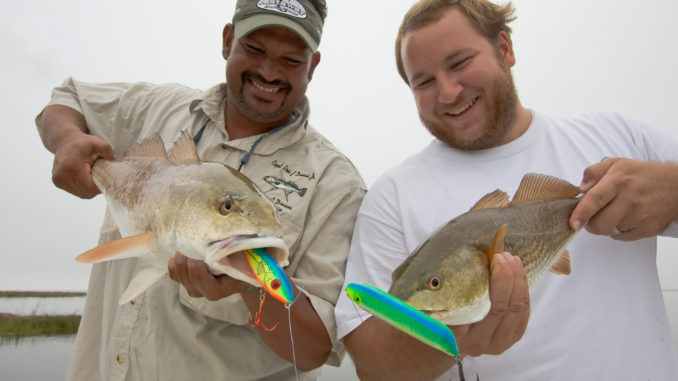
With obvious signs that the water at the Rigolets Marina was much higher just a few days earlier, Captain Eric Dumas (985-705-1244) launched his 24-foot Ranger amidst the matted marsh grass that was covering the area. Little did he know that just a few hours later his cooler lid would hardly snap shut.
Dumas had invited Sam Elliot and I to explore the Lake Pontchartrain area to check out the effects of Hurricane Gustav and to see if any fish were biting. As we idled out into the predawn darkness toward the L&N Train Bridge, we could smell the many bloated and floating nutria rats and wild hogs that had succumbed to the storm.
Being that this was the first morning that the Rigolets Marina had any live bait since Gustav passed through, Dumas gathered up as many shrimp and croakers as he could and tossed them into his bait wells. We were prepared to throw plastics if we needed to, but having the live bait on board made us all feel a little better considering that we didn’t know what we would find.
Our first stop under the L&N was nothing more than an exercise in tying and untying a boat. The current was doing some really weird things, and it seemed to be moving sideways. Dumas trolled toward the north bank on the west side of the bridge to check the ledge over there.
“Sometimes the fish will stack up in this drop off,” he said as we began heaving Carolina rigged shrimp to the structure. “I’ve caught some big trout here before, so let’s see if they rode out the hurricane here.”
It didn’t take long for the trout to notice our offerings, and there were many times when we had on three fish at a time. There were just a few throw-backs and a few croakers, but it was keeper-sized trout for the most part.
When Dumas noticed that the current seemed to be heading out, we moved to the other side of the bridge and tied off again. While the top was moving out, it quickly became apparent that the bottom was still rolling in as our rigs were quickly swept back toward the boat.
“Let’s go check out what’s in that pocket over there,” Dumas said while pointing to some baitfish activity near the shore. “Maybe we can get on a topwater bite. It’s hard to keep the Top Dogs put up with it cloudy and cool like this.”
The fish in the pocket turned out to be reds, and they went absolutely nuts over our topwaters dancing over their heads. Several casts drew 4, 5 and even 6 huge blow-ups before the fish would eventually get hooked up, and it didn’t take long to put 15 grilling-sized reds in the box.
A quick trip around Rabbit Island proved that there was a lot more damage done to the marsh than what one might expect. While the water was greener over there, it was difficult to fish because of the floating debris and nutria. No strikes prompted us to go back to the bridge to go through the rest of the shrimp and croakers.
Dumas landed the largest fish of the day on a Carolina rigged croaker, but it was also just about the last fish of the day. The clouds eventually cleared, and the sun started beating down. One last check of the reds proved that they had retreated due to the glaring sun, so we decided to do the same.
